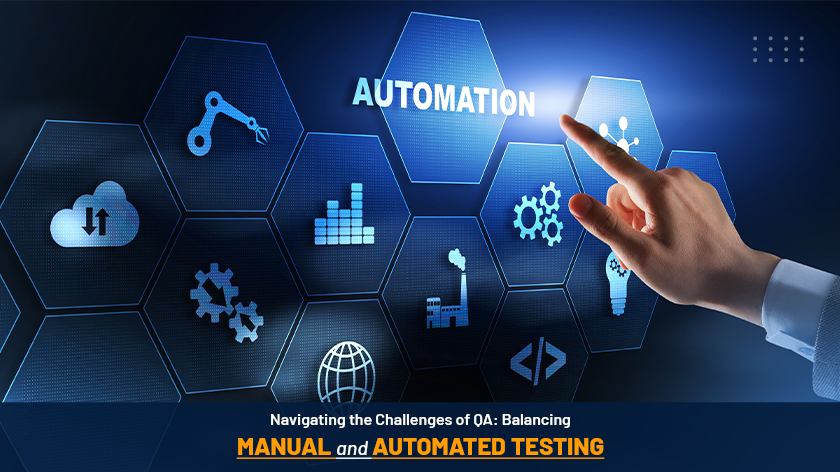At very beginning, determining the conclusion on QA activities is a difficult task to perform manually. Relatively, thinking about the scenarios for functionality is a challenging task.clear understanding on the functionality is the simplest part for the QA task.Changing requirements in the business model is the part which frustrates people from person to person, which is necessary to overcome the psychological factors through the application of AI tools, chat GPT, etc.
Beyond that, deflection in the development of the business model hampers the quality of the software applications, which need to be maintained by the basic principles of QA testing. Working on live projects while at the same time maintaining quality is not only challenging but also responsible tasks to deliver the quality of the software application within the delivery deadlines. This can be managed by the trending AI-Powered Testing Tools: Test.ai, Mabl, Testim & Test Automation Tools: Selenium, Appium, Cypress, etc.
Test Automation Tools:
- Selenium: is an open-source automation tool that can be used to test web applications.
- Appium: is a mobile application testing tool that supports both iOS and Android apps.
- Cypress: is a modern JavaScript-based framework for testing web applications.
AI-Powered Testing Tools:
- Test.ai: Uses AI to create, manage, and execute tests for mobile and web applications.
- Mabl: offers intelligent automation testing and learns from test data to improve tests over time.
- Testim: Utilizes AI to help create, maintain, and execute automated tests efficiently.
Visual Regression Testing:
- Percy: Captures snapshots of web applications during testing and compares them visually to detect any differences.
- Applitools uses AI to perform visual testing and ensure that applications look and function correctly across different browsers and devices.
AI-Based Bug Detection and Debugging:
- DeepCode: is an AI-powered tool that helps developers detect bugs and suggest fixes in code.
- Codota: provides intelligent code completion and bug detection using AI.
Performance Testing:
- LoadRunner: A performance testing tool that can simulate thousands of virtual users to stress test applications.
- JMeter is an open-source tool for performance testing, including load testing, of web applications and services.
QA Analytics and Insights:
- QTest: Offers AI-driven insights and analytics for test management and defect tracking.
- TestRail: Provides detailed reporting and analytics for managing test cases and tracking progress.
This is the wide difference between the manual and automated QA process. Discussing the different Challenges of QA process
- Time-Consuming:
Manual testing can be very slow compared to automated testing, especially for large and complex applications.
Testers must go through each test case manually, which can take a significant amount of time. - Human Error:
Manual testing relies heavily on human effort, which can lead to mistakes and oversights.
Fatigue and lack of concentration can result in missed defects or inconsistent results. - Lack of repeatability:
Repeating the same test multiple times can lead to variations in the results due to changes in the tester’s approach.
This can affect the accuracy and reliability of the test results. - Coverage Limitations:
Due to time and resource constraints, manual testers may not be able to cover all possible scenarios and edge cases.
This can lead to gaps in test coverage and potential missed defects. - Scalability:
Manual testing does not scale well for large or rapidly changing projects.
It can be challenging to keep up with frequent changes in the application and maintain test coverage. - Cost:
Manual testing can be more costly in terms of labor and time spent on testing compared to automation.
The need for experienced testers to perform manual tests can also contribute to higher costs. - Consistency:
Different testers may interpret test cases differently, leading to inconsistencies in test execution and results.
Standardizing testing practices across a team can be challenging. - Repetitive and monotonous:
Manual testing can involve repetitive tasks, which can lead to boredom and reduced focus.
This can impact the quality of testing and the ability to catch defects. - Regression Testing:
Performing regression testing manually can be tedious and error-prone, especially when testing the same functionality multiple times.
Automating regression tests can be more efficient and consistent. - Documentation:
Keeping track of test cases, results, and changes can be challenging in manual testing.
Proper documentation is essential for maintaining a history of testing and for future reference.
Conclusion:
In conclusion, the challenges of manual testing in live projects can be significant and may include time consumption, human error, limited test coverage, scalability issues, higher costs, consistency challenges, monotony, regression testing, and documentation. These challenges can impact the overall quality and efficiency of the testing process. By implementing these strategies, organizations can overcome the challenges of manual testing in live projects and improve the quality, efficiency, and reliability of their QA processes. Ultimately, a well-structured QA approach can lead to higher-quality software, faster delivery, and greater customer satisfaction.
Facing challenges with manual testing in your live projects? Discover how XcelTec can help you overcome these obstacles and achieve higher-quality software, faster delivery, and greater customer satisfaction. Contact us today to optimize your QA processes!
For More details, Visit us : https://www.xceltec.com/

